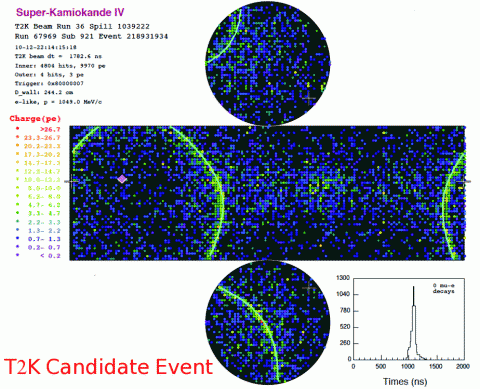

The T2K experiment, whose primary purpose is to study neutrino interactions at a large distance from their source, has detected 6 electron- neutrino candidate events based on the data collected before March 11, 2011. This data provides an indication for the first time that muon neutrinos are able to transform into electron neutrinos over a distance of 295 km through the quantum mechanical phenomena of neutrino flavour oscillations. These hints validate the premise of the international science experiment and offer hope that a conclusive understanding of the elusive neutrino is within reach.
The Tokai-to-Kamioka (T2K) neutrino experiment publicly announced new results today which hint that muon neutrinos produced by a particle accelerator can transform into electron neutrinos as they travel across a long distance. The experiment uses a beam of muon neutrinos produced at the J-PARC accelerator laboratory in eastern Japan. These neutrinos are beamed from J-PARC through the Honshu island of Japan to the Super-Kamiokande neutrino detector 295 km away. A near neutrino detector at J-PARC measures the beam at its production point to allow a "before and after" comparison for measurements at Super-Kamiokande. Previous experiments have shown that muon neutrinos with similar energies can transform into other kinds of neutrinos while in transit due to a phenomenon known as "neutrino oscillation." However, the very low rate at which they turn into electron neutrinos is an outstanding puzzle in particle physics that is the focus of a worldwide effort.
Neutrinos, which come in three types, are subatomic particles similar to electrons but having no electric charge and masses millions of times smaller than electrons. They have the unique ability to pass through ordinary matter without stopping, allowing T2K's beam to actually pass through the main island of Japan on its way to the detector. It was once believed that neutrinos were massless, but results from Super-Kamiokande, Canada's Sudbury Neutrino Observatory, and other experiments have established that neutrinos both have tiny masses and can oscillate from one type to another. This phenomenon requires modifications to the "Standard Model" of particle physics, and a major global effort is underway to understand the different ways in which neutrinos can change type. Many theorists have suggested that differences in how neutrinos and antineutrinos oscillate might ultimately help to explain why our universe is made of matter and not anti-matter. A major puzzle is to understand why one type of neutrino, the muon neutrino, mostly avoids turning into an electron neutrino when it oscillates.
At simultaneous seminars at the host laboratories of KEK and the Institute of Cosmic Ray Research in Kashiwa, Japan today, T2K announced that, using all of the T2K data taken before the March 11 earthquake in Japan, they see six candidate electron neutrino events (see one of these events on the right). If muon neutrinos didn't change into electron neutrinos, then T2K should have only seen 1.5 events on average. The chance of seeing six or more events when only 1.5 are expected is less than one percent, suggesting that some of the muon neutrinos are indeed turning into electron neutrinos, although at a very low rate.
"This is the first time that an experiment looking for this effect has found a result not consistent with zero," said Professor Scott Oser, spokesperson for the Canadian contingent of the T2K collaboration. "These results are very intriguing but not yet conclusive. Really we need more data to confirm that this effect is real and not just a statistical fluke. We're looking forward to the resumption of data-taking once the process of earthquake recovery is complete."
The T2K experiment collected about 2% of the original goal of the total number of events to be collected before the major Japanese earthquake hit on March 11, 2011. After J-PARC resumes producing muon neutrinos, which is planned to happen by the end of 2011, the T2K experiment will continue striving to accumulate the target number of events to confirm electron neutrino appearance, as well as pursue the further understanding of this appearance by combining the neutrino measurements with measurements using anti-neutrinos, which will shed light on how neutrinos differ from their antimatter counterparts. Dr. Mark Hartz from the University of Toronto & York University will present these results at the Canadian Association of Physicists annual meeting on Thursday, June 17. T2K has submitted a publication describing the new results to the journal Physical Review Letters.
The T2K collaboration consists of approximately 500 people from 12 countries and 59 different institutions. Canada is one of the largest contributors to the experiment, with over forty scientists contributing from the University of Victoria, the University of British Columbia, TRIUMF, the University of Alberta, the University of Regina, York University, and the University of Toronto. The Canadian group has made significant contributions to T2K's beam line, detectors, beam line monitoring, and analysis. The central piece of T2K's near detector and a key beam line monitor were built in Canada and are now integral parts of the experiment. T2K uses the concept, developed at TRIUMF in the 1990s, of an off-axis neutrino beam, in which the beam is aimed a few degrees away from the detectors in order to get a more favourable energy spectrum. T2K is supported in Canada by NSERC, National Research Council Canada, and the Canada Foundation for Innovation.
For graphics, glossary, and additional background, please see the J-PARC/KEK T2K site.
